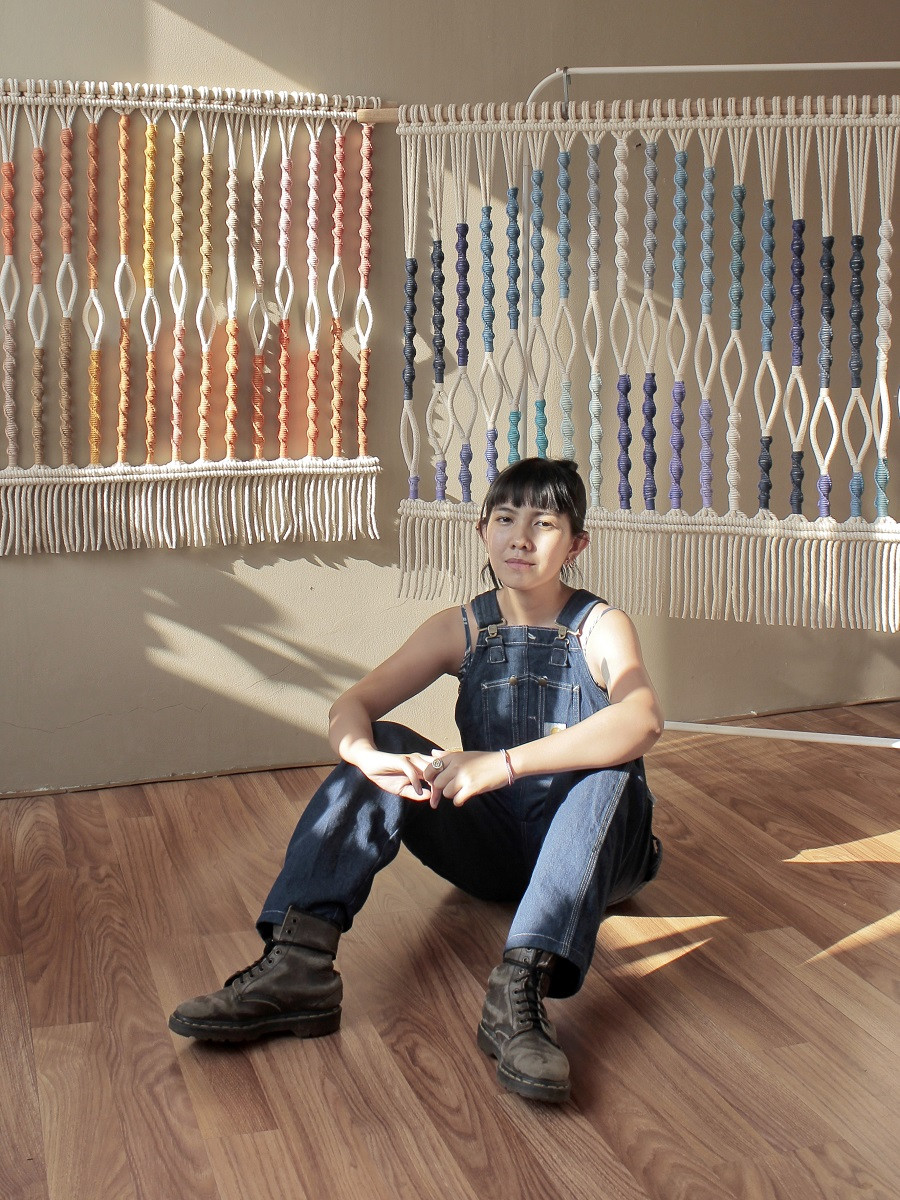Popular Reads
Top Results
Can't find what you're looking for?
View all search resultsPopular Reads
Top Results
Can't find what you're looking for?
View all search resultsMacramé: The cords that bind
Macramé was invented by the Babylonians over 3,000 years ago and introduced to Europe through Al Andalus Spain by the Muslim Moors.
Change text size
Gift Premium Articles
to Anyone
A
gnes Hansella is a textile artist (with a background in sound engineering). She was born in Banjarmasin Kalimantan to a Christian Dayak father and an Indonesian Chinese mother and educated in the United States, Canada, and Indonesia. She holds a bachelor's degree from the Jakarta Institute of Arts. Agnes now lives in South Jakarta. Her medium is macramé.
Macramé was invented by the Babylonians over 3,000 years ago and introduced to Europe through Al Andalus Spain by the Muslim Moors. (The Moorish advances in art, agriculture and astronomy are credited with lifting Europe out of the Dark Ages and into the Renaissance.) The word macramé is derived from the Arabic macramia (مكرمية) meaning “a decorative fringe used to keep flies off camels and horses”. During the “Age of Sail”, Portuguese and Dutch seafarers made macramé objects, such as hammocks and belts, and sold or bartered them while in port, spreading the art form to China, the Dutch East Indies, and the Americas.
Macramé is produced by knotting rather than knitting or weaving. It is, as Prof. Dwi Marianto from the Indonesian Art Institute (ISI Yogyakarta) says—“A very democratic medium, because anyone can learn the fundamentals. And, as Agnes has demonstrated, macramé can also be an extraordinary artistic vehicle for explaining and interpreting the world.”
Agnes believes that “With macramé, it’s like the rope has its own unique character; our job is to follow it and to understand what works and what doesn’t. Right now, I am developing a three-dimensional color gradient: dying each strand, one at time, to create depth and movement—much like a painter would do.”
One of Agnes’s works, the mixed textile technique Batang Garing, was commissioned by the governor of Central Kalimantan. It tells the Dayak story of creation and how new life can emerge from destruction and ruin: much like the ancient Hindu symbol of the mythical Garuda found on the Indonesian coat of arms. She says, “According to my father’s people, two great Dayak gods, Ranying Mahatala Langit and Bawi Jata Balawang Bulau, created the Tree of Life. To enjoy the fruit of the tree, each god created a Tingang bird who then fought over the fruit. The struggle continued until both birds perished. (For Dayaks, this is not ‘a scary thing’ but rather, presents an opportunity for growth and renewal.) Dayak tradition maintains that from the fragments of the birds’ bodies the forests, mountains, and rivers were created.”
Clearly this work has given Agnes an awareness of how many textile techniques there are in the world and how she can incorporate them into her very own creations. (Significantly, the Tree of Life is mentioned in the Christian Bible and the Jewish Tanakh, in the Buddhist Pali, and in the Holy Quran.)
The cross-cultural essence of Batang Garing is reflected in a major international symposium and series of special training workshops organized by Australian Dr Angharad Rixon. Doily Free Zone will present the work of 14 artists representing some 12 countries who are creating extraordinary designs using: Bobbin lace, Crochet, Tatting, Carrickmacross, Ñandutí, Lace Knitting, Sprang, Oya, Lacis, Tulle Embroidery, Chainmaille and, of course, Macramé.
According to Rixon, Dolly Free Zone 2022 will be, “An inspiring and nurturing forum for the exchange of ideas and technical expertise.” And, together with contributors from Canada, Belgium, Ireland, Japan, New Zealand, Paraguay, Spain, Turkey, the United Kingdom and the US, Agnes will be proudly representing her country—Indonesia.
As Agnes finally says, “The shapes and shadows that I create with knots remind me of the ropes that people use to tie down large objects they transport on motorbikes here in Jakarta.”
“The cords sometimes look like they might break but, incredibly, somehow, they hold. For me this is a metaphor for my country and our national motto Bhinneka Tunggal Ika or Unity in Diversity. We have many challenges, that’s for sure, but if we work together, if we build on our incredible diversity as one people, then we can overcome any difficulty.
“I also know this from my own experience because I have worked on a project with a community of disabled workers who live in West Jakarta. I learned the lesson that whatever obstacle I face in life it cannot compare to what they face every day.
“Macramé has also taught me how easily we can be connected at home and around the world through a common love for artistic experimentation, creativity and skill, and how much fun and how relaxing this process can be.”
In inviting Agnes to join the international symposium, Doily Free Zone, just might be on to something, because macramé is, after all, an art form invented by the ancient Babylonians, perfected by the Moors, adopted by the Spanish, developed by the Italians, and now shared globally, with great passion, by a young Indonesian woman.
***
The writer is a researcher with the Humanitarian and Development Research Initiative (HADRI) Western Sydney University.











